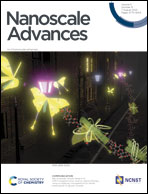A systematic study of work function and electronic properties of MXenes from first principles†
Abstract
Functional 2D materials are interesting for a wide range of applications. The rapid growth of the MXene family is due to its compositional diversity, which, in turn, allows significant tuning of the properties, and hence their applicability. The properties are to a large extent dictated by surface terminations. In the present work, we demonstrate the influence of termination species (O, NH, N, S, F, Cl, Br, I) on the changes in electronic structure, work function, dynamical stability, and atomic charges and distances of MXenes (Ti2C, Nb2C, V2C, Mo2C, Ti3C2, and Nb4C3). Among these systems, the work function values were not previously reported for ∼60% of the systems, and most of the previously reported MXenes with semiconducting nature are here proven to be dynamically unstable. The results show that the work function generally decreases with a reduced electronegativity of the terminating species, which in turn is correlated to a reduced charge of both the metal and terminating species and an increased metal-termination distance. An exception to this trend is NH terminations, which display a significantly reduced work function due to an intrinsic dipole moment within the termination. Furthermore, the results suggest that halogen terminations improve the electrical conductivity of the materials.



 Please wait while we load your content...
Please wait while we load your content...